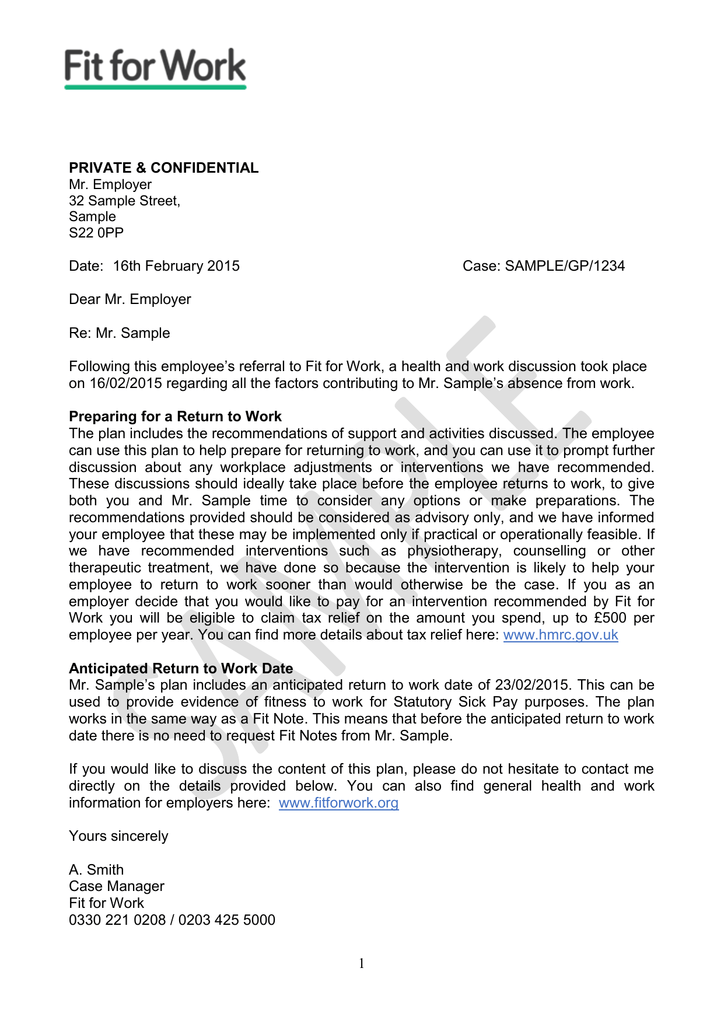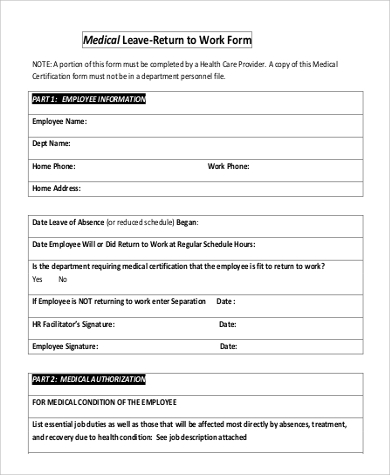Imagine this: a valued employee has been sidelined by an injury or illness, their absence leaving a gap in your team’s productivity. How do you ensure their safe and seamless return? The answer lies in a critical document known as the “Employee Return to Work Order.” This seemingly simple document acts as a roadmap, outlining the steps needed for a successful reintegration.

Image: studylib.net
The Employee Return to Work Order is more than just a formality – it’s a vital tool that safeguards both the employee’s well-being and the company’s interests. It provides a framework for managing the return process, minimizing risks, and promoting a smooth transition back to work. This comprehensive guide will equip you with the knowledge and tools to effectively create, implement, and manage these orders, making the return to work journey smoother for both your employees and your organization.
Understanding the Foundation: What is an Employee Return to Work Order?
At its core, an Employee Return to Work Order is a structured document outlining the agreed-upon conditions and restrictions for an employee’s return to work following an absence due to injury, illness, or other medical reason. It acts as a formal agreement between the employer, employee, and often, the employee’s healthcare provider.
Purpose and Benefits
- Provides a Clear Path: It sets out a detailed plan, outlining work restrictions, accommodations, and a gradual return schedule if necessary, minimizing confusion and ensuring a safe transition.
- Minimizes Risks: By outlining limitations and restrictions, the order helps prevent potential re-injury or further health complications, protecting both the employee and the company.
- Encourages Open Communication: It fosters open dialogue between the employee, employer, and healthcare provider, ensuring everyone is on the same page and addressing any concerns promptly.
- Facilitates Accommodation: It allows for necessary adjustments to the employee’s work environment or tasks, enabling them to perform their duties effectively while still recovering.
- Promotes a Smooth Reintegration: By outlining expectations and providing support, the order helps the employee feel comfortable and confident in their return to the workplace.
Crafting a Comprehensive Order: Essential Elements
A well-structured Return to Work Order is crucial for a successful process. Here’s what to include:

Image: www.sampletemplates.com
1. General Information
- Employee Details: Name, employee ID, contact information.
- Date of Injury/Illness: This establishes the timeline and helps track progress.
- Nature of Absence: A brief description of the reason for the employee’s absence (e.g., work-related injury, illness, surgery).
- Return to Work Date: A clear target date for the employee’s return, subject to evaluation and medical clearance.
2. Work Restrictions and Accommodations
This section is the heart of the order, outlining specific limitations and adjustments.
- Physical Restrictions: Lifting limits, hours of work, repetitive movement restrictions, etc.
- Cognitive Restrictions: Any limitations on concentration, memory, or decision-making due to medication or illness.
- Environmental Considerations: Noise levels, temperature control, ergonomic adjustments, etc.
- Work Schedule: Reduced hours, modified shifts, or flexible schedules to accommodate recovery needs.
- Job Modifications: Temporary assignment to light duty tasks, removal of hazardous duties, or assistance with specific tasks.
3. Medical Information
This section connects the healthcare provider’s observations and recommendations to the return to work plan.
- Physician’s Name and Contact: Allows for easy communication and clarification.
- Medical Assessment: Details of the treating physician’s evaluation, including diagnosis, prognosis, and any ongoing treatment plan.
- Physician’s Recommendations: Specific guidance on work restrictions, accommodations, and limitations based on the employee’s medical condition.
4. Evaluation and Monitoring
Regular check-ins ensure the employee’s progress is tracked and the plan is adjusted as needed.
- Frequency of Check-Ins: Weekly, bi-weekly, or monthly evaluations based on the severity of the condition.
- Methods of Assessment: Meetings with the employee and supervisor, physician evaluations, or review of documented progress.
- Criteria for Adjustment: Clearly defined criteria for modifying the plan based on the employee’s condition and progress.
5. Signatures and Acknowledgement
Ensures everyone involved is fully aware of the agreement.
- Employee Signature: Confirms understanding and agreement to the plan.
- Supervisor Signature: Confirms understanding and commitment to providing the necessary support and accommodations.
- Physician Signature: Indicates the physician’s review and approval of the plan.
Examples of Return to Work Orders
To illustrate the concept, consider these real-world examples:
Example 1: Office Worker with Carpal Tunnel Syndrome
An office worker diagnosed with carpal tunnel syndrome might have restrictions on repetitive keyboard use, requiring modifications like voice recognition software or ergonomic keyboards. Their return to work order would specify these accommodations, along with limitations on lifting heavy objects.
Example 2: Construction Worker with Back Injury
A construction worker with a back injury might require modifications to their work duties, potentially limiting them to light tasks. The return to work order would clearly define these restrictions and any necessary ergonomic adjustments to their work area.
Example 3: Registered Nurse with Flu
While not a traditional work-related injury, this example demonstrates the order’s flexibility. A registered nurse with the flu might require a temporary accommodation of reduced hours until their full recovery. The order would specify the reduced workload and the planned duration of this temporary adjustment.
Navigating the Return to Work Process
Once the order is established, focus on effective implementation and open communication.
- Open Dialogue: Regularly check in with the employee, supervisor, and the healthcare provider to assess progress and address any concerns.
- Flexibility and Adaptability: Be prepared to adjust the plan as the employee’s condition evolves. Be mindful of their pace and don’t push them beyond their capabilities.
- Provide Support: Offer necessary resources, training, or assistance to ensure a smooth reintegration into the workplace. This might include ergonomic assessments, retraining programs, or mental health resources.
- Encourage Feedback: Regularly seek feedback from the employee and supervisor to identify any necessary adjustments or modifications to the order.
Technology’s Role in Streamlining Return to Work Orders
Technology can significantly ease the process of managing Return to Work Orders.
- Electronic Forms: Software solutions allow for efficient creation, storage, and distribution of orders, reducing paperwork and streamlining the process.
- Digital Communication: Online platforms facilitate secure communication and information sharing among all parties involved, promoting transparency and streamlining communication.
- Automated Reminders: Systematically schedule reminders for check-ins, evaluations, and necessary updates, ensuring timely execution of the plan.
The Impact of a Successful Return to Work Order
When implemented effectively, the Employee Return to Work Order delivers significant benefits.
- Reduced Absenteeism: By managing the return process carefully, companies can minimize the likelihood of prolonged absences due to complications or re-injury.
- Improved morale and Productivity: Employees feel valued and supported, leading to increased morale and a smoother transition back to work, boosting productivity.
- Reduced Risk of Legal Issues: A well-documented and carefully executed order minimizes the company’s liability regarding employee safety and accommodation.
Employee Return To Work Order Sample
Conclusion
The Employee Return to Work Order is a powerful tool that empowers organizations to facilitate safe, smooth, and successful reintegration for employees returning to work after an absence. By embracing this process, companies can demonstrate their commitment to employee well-being, minimize risks, and cultivate a work environment where injured or ill workers feel supported and confident in their ability to return to their roles. As you navigate the complexities of managing employees’ return to work, remember the importance of open communication, ongoing evaluation, and a shared commitment to fostering a safe and productive work environment.





